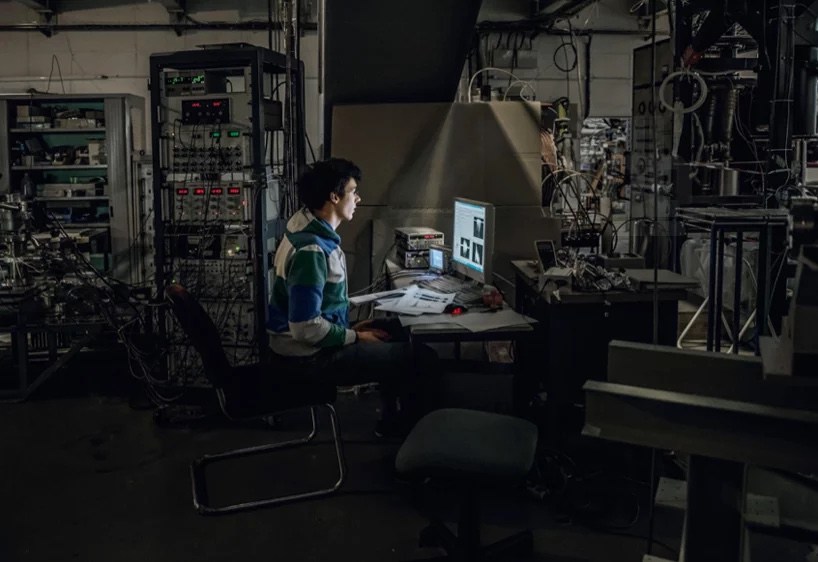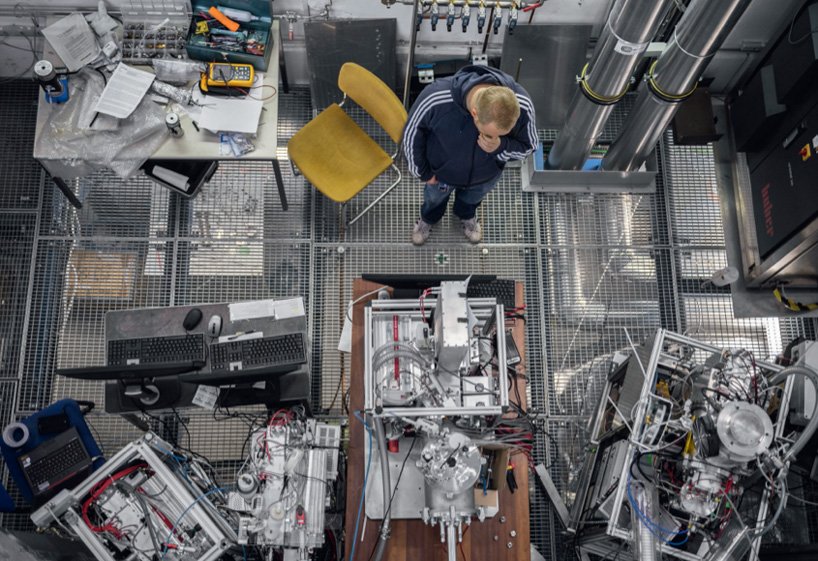kottke.org posts about CERN

It’s always (to me anyway) interesting to see artists’ studios, artisan workshops and the like. I’m pretty sure if I’ve ever wondered what the labs of particle physicists look like but, thankfully, Andri Pol and author Peter Stamm did, and there’s now a book of their observations.
Throughout the publication, a fascinating juxtaposition is established, contrasting reassuringly familiar scenes with some of the most complex pieces of scientific equipment anywhere in the world - a worker is shown seemingly exasperated by a coffee machine, while another employee is visible taking a sip of water meters from the hadron collider itself. The photographer presents his subjects amongst mountains of stacked books, tangled in webs of cables and immersed in endless scrawls of equations and formulae.



CERN’s LHC (Large Hadron Collider) has discovered a new subatomic particle, the pentaquark.
“The pentaquark is not just any new particle,” said LHCb spokesperson Guy Wilkinson. “It represents a way to aggregate quarks, namely the fundamental constituents of ordinary protons and neutrons, in a pattern that has never been observed before in over fifty years of experimental searches. Studying its properties may allow us to understand better how ordinary matter, the protons and neutrons from which we’re all made, is constituted.”
Here’s the paper, with more than 680 authors. Between New Horizons zipping past Pluto earlier today (look at this pic!) and this, what a day for science.
Last year (spoilers!), CERN confirmed the discovery of the Higgs boson. Physicist-turned-filmmaker Mark Levinson has made a film about the search for the so-called God Particle. Particle Fever follows a group of scientists through the process of discovery and the construction of the mega-machine that discovered the Higgs, the Large Hadron Collider. Here’s a trailer:
Two additional data points: the movie is holding a 95% rating on Rotten Tomatoes and legendary sound designer and editor Walter Murch edited the film. Particle Fever is showing at Film Forum in New York until March 20. (thx, james)
The World Wide Web turns 25 this year…the “vague but exciting” proposal on which the Web is based was sent to his boss at CERN by Tim Berners-Lee on March 10, 1989.
In the following quarter-century, the Web has changed the world in ways that I never could have imagined. There have been many exciting advances. It has generated billions of dollars in economic growth, turned data into the gold of the 21st century, unleashed innovation in education and healthcare, whittled away geographic and social boundaries, revolutionised the media, and forced a reinvention of politics in many countries by enabling constant two-way dialogue between the rulers and the ruled.
There are a few principles which allowed the web, as a platform, to support such growth. By design, the Web is universal, royalty-free, open and decentralised. Thousands of people worked together to build the early Web in an amazing, non-national spirit of collaboration; tens of thousands more invented the applications and services that make it so useful to us today, and there is still room for each one of us to create new things on and through the Web. This is for everyone.
My friend David Galbraith continues his lonely quest to recognize and preserve the room in which the Web was invented (which is not where CERN officially recognizes it was invented.)
I wrote to Tim Berners-Lee after exploring CERN looking for the location where the web was invented. His replies regarding the exact locations are below.
There is a plaque in a corridor in building 2, but no specific offices are indicated and there is some ambiguity as to what happened where, in building 31. Thomas Madsen-Mygdal has a gallery showing locations in building 31 and 513, but there are very few places on the web documenting these places. I took photos of the plaque, such as the one here, with Creative Commons licenses, so that they could be used elsewhere.
The reason I’m interested in this is that recognizing the exact places involved in the birth of the web is a celebration of knowledge itself rather than belief, opinion or allegiance, both politically and spiritually neutral and something that everyone can potentially enjoy and feel a part of.
Secondly, many places of lesser importance are very carefully preserved. The place where the web was invented is arguably the most important place in 2 millennia of Swiss history and of global historical importance.
I was hoping one of the items on the anniversary site’s list of 25 things you probably didn’t know about the Web was that the Web was technically invented in France and not Switzerland, as Galbraith uncovered during his conversations with TBL.
A team of web dev hot shots recently convened at CERN to build an emulator of the CERN line-mode browser, the first browser that made the WWW accessible to a wide number of people.
The line-mode browser, launched in 1993, was the first readily accessible browser for what we now know as the world wide web. It was not, however, the world’s first web browser. The very first web browser was called WorldWideWeb and was created by Tim Berners-Lee in 1990.
But WorldWideWeb only worked on the NeXT operating system. WorldWideWeb was a great piece of software, but it was important that the web should be accessible to many kinds of computers, not just NeXT machines.
That’s where the line-mode browser came in. It was the first web browser with a cross-platform codebase so it could be installed on many different kinds of computers. It was a relatively simple piece of software with a very basic interface, but in the early days of the web, it was instrumental in demonstrating the power of this new medium.
The text says the line-mode browser launched in 1993 but it was actually 1991 (and first stable release in early 1992). My first browser was NCSA Mosaic so it was a treat to use this for a few minutes this morning. (via @craigmod)
Or, to put it in the cautious words of science, researchers have observed a “particle consistent with long-sought Higgs boson”.
“We observe in our data clear signs of a new particle, at the level of 5 sigma, in the mass region around 126 GeV. The outstanding performance of the LHC and ATLAS and the huge efforts of many people have brought us to this exciting stage,” said ATLAS experiment spokesperson Fabiola Gianotti, “but a little more time is needed to prepare these results for publication.”
“The results are preliminary but the 5 sigma signal at around 125 GeV we’re seeing is dramatic. This is indeed a new particle. We know it must be a boson and it’s the heaviest boson ever found,” said CMS experiment spokesperson Joe Incandela. “The implications are very significant and it is precisely for this reason that we must be extremely diligent in all of our studies and cross-checks.”
How sure are they that they’ve found the Higgs? Brian Cox notes on Twitter:
5 sigma is the usual particle physics threshold for discovery. It roughly means that you’re 99.9999% sure
The NY Times is reporting that a data bump “smells like the Higgs boson”. The odor is emanating not from CERN in Europe but from Fermilab near Chicago, where their Tevatron still flings some pretty fast particles.
“Based on the current Tevatron data and results compiled through December 2011 by other experiments, this is the strongest hint of the existence of a Higgs boson,” said the report, which will be presented on Wednesday by Wade Fisher of Michigan State University to a physics conference in La Thuile, Italy.
None of these results, either singly or collectively, are strong enough for scientists to claim victory. But the recent run of reports has encouraged them to think that the elusive particle, which is the key to mass and diversity in the universe, is within sight, perhaps as soon as this summer.
Update: The Tevatron is no longer flinging, having been shut down in 2011 due to budget cuts. Which makes the Higgs discovery a little bittersweet, to say the least. (thx, miles)
David Galbraith updated his post on where the web was invented (which includes an interview with Tim Berners-Lee) to include the juicy tidbit that the building in which TBL invented the web is in France, not Switzerland.
I’ll bet if you asked every French politician where the web was invented not a single one would know this. The Franco-Swiss border runs through the CERN campus and building 31 is literally just a few feet into France. However, there is no explicit border within CERN and the main entrance is in Switzerland, so the situation of which country it was invented in is actually quite a tricky one. The current commemorative plaque, which is outside a row of offices where people other than Tim Berners-Lee worked on the web, is in Switzerland. To add to the confusion, in case Tim thought of the web at home, his home was in France but he temporarily moved to rented accommodation in Switzerland, just around the time the web was developed. So although, strictly speaking, France is the birthplace of the web it would be fair to say that it happened in building 31 at CERN but not in any particular country! How delightfully appropriate for an invention which breaks down physical borders.
Rumor has it that the LHC at CERN has found the Higgs boson. The news runs contrary to some earlier speculation.
The teams are sworn to secrecy, but various physics blogs, and the canteens at Cern, are alive with talk of a possible sighting of the Higgs, and with a mass inline with what many physicists would expect.
Since the Higgs’ nickname is the God particle, does this count as the Second Coming? (@gavinpurcell)
Physicists at CERN believe they have observed neutrinos moving at speeds faster than the speed of light, a feat previously assumed to be impossible.
Thousands of experiments have been undertaken to measure it ever more precisely, and no result has ever spotted a particle breaking the limit.
But Dr Ereditato and his colleagues have been carrying out an experiment for the last three years that seems to suggest neutrinos have done just that.
Neutrinos come in a number of types, and have recently been seen to switch spontaneously from one type to another.
The team prepares a beam of just one type, muon neutrinos, sending them from Cern to an underground laboratory at Gran Sasso in Italy to see how many show up as a different type, tau neutrinos.
In the course of doing the experiments, the researchers noticed that the particles showed up 60 billionths of a second sooner than light would over the same distance.
This is a tiny fractional change, but one that occurs consistently.
The team measured the travel times of neutrino bunches some 15,000 times, and have reached a level of statistical significance that in scientific circles would count as a formal discovery.
If true, saying this is a significant discovery is a doubly significant understatement.
Most of the possible masses for the Higgs boson (aka the God particle) have been eliminated with at a 95% confidence level by physicists at CERN. They’re checking the other masses and will likely have an answer one way or the other in December.
“We are now entering a very exciting phase in the hunt for the Higgs boson,” Sharma said. “If the Higgs boson exists between 114-145 GeV, we should start seeing statistically significant excesses over estimated backgrounds, and if it does not then we hope to rule it out over the entire mass range. One way or the other we are poised for a major discovery, likely by the end of this year.”
(via @daveg)
A pair of articles on the Large Hadron Collider at CERN: A Giant Takes On Physics’ Biggest Questions and Crash Course. The LHC will hopefully provide the 1.21 gigawatts 7 trillion electron volts needed to uncover the Higgs boson, aka, The God Particle. “What we want is to reduce the world to objects that have no structure, that are points, that are as simple as we can imagine. And then build it up from there again.”









Stay Connected